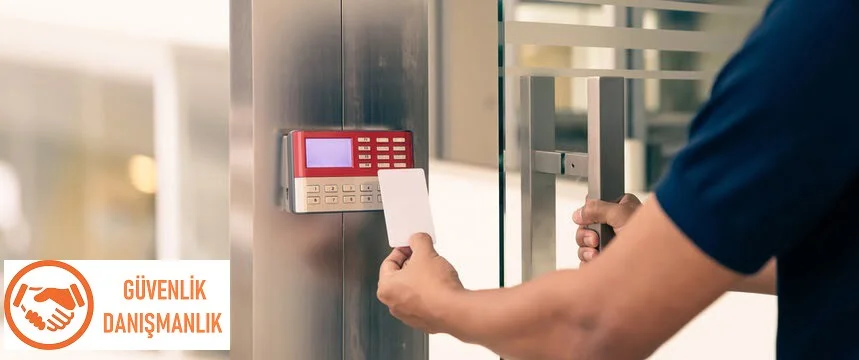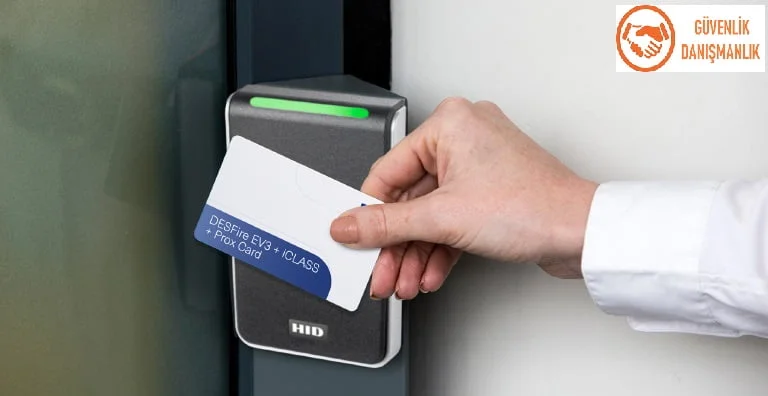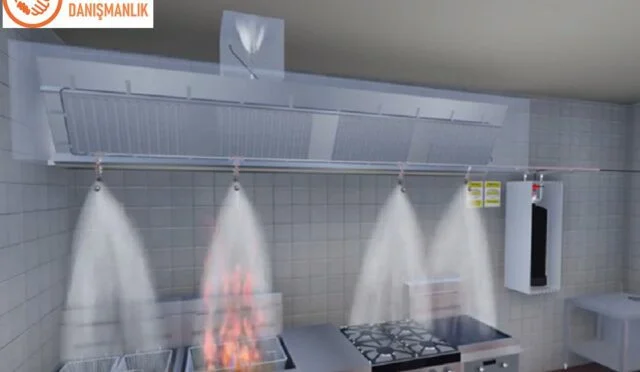Proximity Card Readers.
Proximity card readers use radio frequency technology to read the information on a card when it is held near the reader. These readers are the most common type of card access system readers.
Proximity readers used in card access systems can detect cards within a few centimeters. This allows for card access without physically touching the reader device. Proximity readers are typically used in small-scale systems where a few hundred users can be identified, such as in office or small business entry control systems.
Proximity readers are a low-cost, durable, and easy-to-use card access system. Proximity cards used in card access systems are longer lasting and can store more information than magnetic stripe cards.
Proximity readers provide a system that can easily be disabled, especially in the event of a lost card. An old card can be canceled and a new one issued, minimizing security risks. Additionally, when a user’s access is revoked, their authorization is removed from the card, preventing them from accessing the system.
Proximity readers can be used for many applications, such as offices, schools, hospitals, airports, parking lots, and shopping malls.

Mifare Card Readers.
Mifare readers are a card reader system that reads information from a card using wireless communication technology. These readers are designed for systems that require high security.
Mifare technology uses a radio frequency communication protocol. This protocol establishes a connection between the reader and the card, allowing information to be retrieved from the card. Mifare readers are placed close to the card to read the information. The card’s magnetic field must come into contact with the reader to be read.
Mifare readers are used in places where high security is required. These readers control access to smart cards and protect card information by encrypting it to enhance security. This ensures that only authorized individuals are allowed to enter the system.
Mifare readers have a multi-application system. This allows access to multiple applications using the same card. For example, the same card can be used for access control and payment at canteens and vending machines.
Mifare readers are a card reader system used in various fields. These readers are used in many places such as offices, schools, hospitals, airports, parking lots, and shopping centers.
OSDP Card Readers.
OSDP (Open Supervised Device Protocol) readers are an open and standard communication protocol developed for card access systems. This protocol enables centralized control of card readers by ensuring data transmission and security.
OSDP readers use a two-way communication channel, allowing both the reader and the control panel to communicate with each other, and any issues that occur at the reader can be immediately reported to the control panel for timely intervention to ensure system security.
OSDP readers use a wired connection instead of a wireless one, making data transmission more secure and uninterrupted. Additionally, the OSDP protocol enhances data security using AES encryption technology.
OSDP readers are used in places that require high security for card access systems. These readers offer higher security compared to magnetic stripe card readers, ensuring only authorized individuals gain access to the system.
OSDP readers are used in various fields, including offices, schools, hospitals, airports, parking lots, and shopping centers.
OSDP readers can read different types of cards, including magnetic stripe cards, RFID cards, and smart cards, providing access to all card types in locations that use different types of cards.
OSDP readers can communicate with card readers, cards, and control panels produced by different manufacturers using a standard protocol. This ensures smooth operation even in systems where different brands’ products are used.
OSDP readers use an open-source protocol, allowing any manufacturer or developer to produce OSDP-compliant products or make their existing products compatible with the OSDP protocol, providing various product options and increasing system flexibility.
In conclusion, OSDP readers are an open and standard communication protocol developed for card access systems that require high security. These readers increase system security by providing centralized control of card readers and enhance system flexibility by reading different types of cards.
 ICLASS Card Readers.
ICLASS Card Readers.
iCLASS readers are a card reader technology developed by HID Global for card access systems. This technology enables the use of smart cards instead of magnetic stripe cards.
iCLASS readers communicate with smart cards to read and transfer card data to the control panel. This increases the security of card access systems and ensures that only authorized personnel can enter the system.
Unlike magnetic stripe cards that need to be held in close proximity to be read, iCLASS readers can read cards from a distance. This makes card reading faster and easier.
iCLASS readers are used in high-security areas. These readers increase data security with AES encryption technology and use a more secure protocol, OSDP, for communication between readers.
iCLASS readers can read different types of cards, including magnetic stripe cards, RFID cards, and smart cards. This allows access to all card types even in places where different types of cards are used.
iCLASS readers are produced in various shapes and sizes, providing different mounting options to increase their usability. For example, iCLASS readers can be mounted on doors, walls, or desktops.
In conclusion, iCLASS readers are a card reader technology developed by HID Global for card access systems. These readers enable the use of smart cards instead of magnetic stripe cards, increase the security of card access systems, and can read different types of cards. iCLASS readers use AES encryption technology, offer various mounting options, and are used in high-security areas.
QR Code Card Readers.
QR code readers are devices that read QR codes and decode the information stored in them. QR codes are a technology used to quickly and easily exchange information.
QR codes are used in many different fields. For example, they are used in advertising campaigns, marketing activities, e-commerce websites, businesses, and many other areas. QR codes can be used on business cards, posters, brochures, product labels, and many other materials.
QR code readers are available as applications or specialized devices that can be used on smartphones and tablets. The process of reading a QR code is performed by the camera on the device and the code is decoded.
QR code readers can be used in many different ways. For example, by scanning the QR code on a product label, more information about the product can be obtained. By scanning a business’s QR code, information about the business can be obtained or discount coupons can be obtained. By scanning the QR code on an advertising poster, more information about the campaign can be obtained.
QR code readers are a practical technology that can be used for quick and easy information exchange. QR codes can be read on everyday devices like smartphones without requiring any special devices or software.






